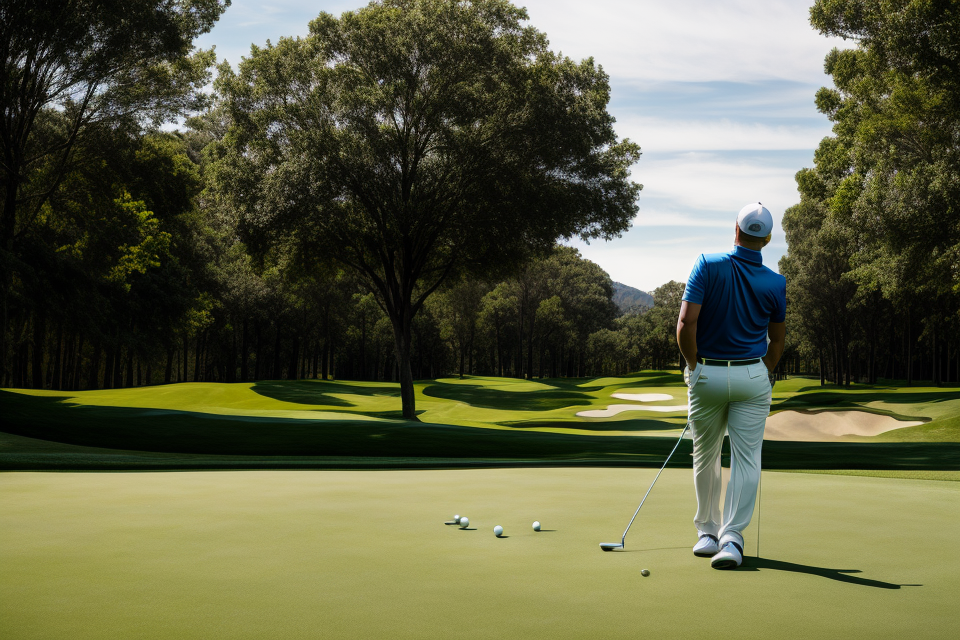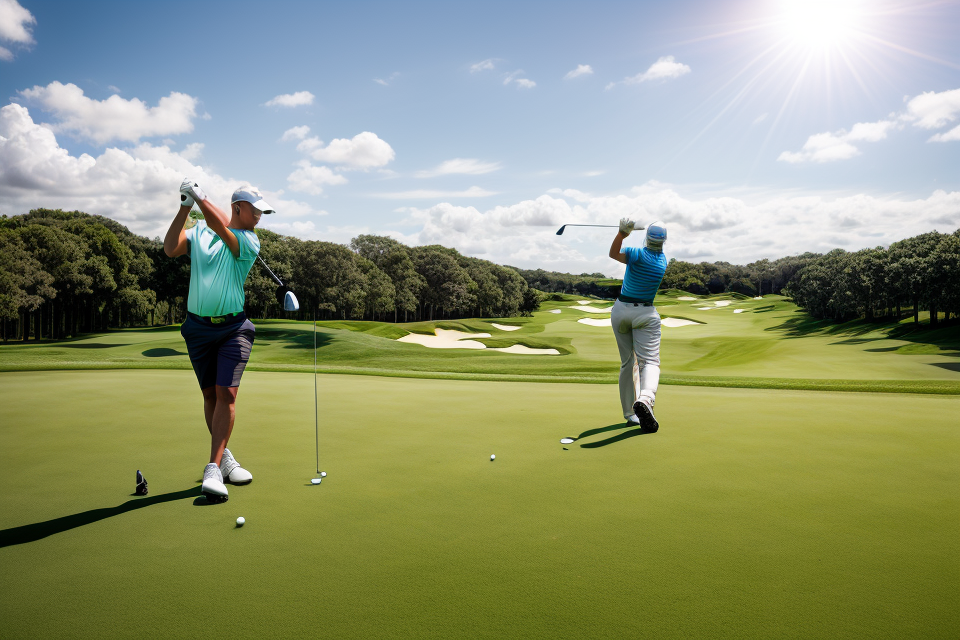
Golf is a sport that requires precision and accuracy, and the choice of golf club can make all the difference. When it comes to forgiveness in golf clubs, it refers to the ability of the club to perform well even if the golfer makes a slight mistake in their swing. A more forgiving golf club is one that provides a larger sweet spot, which means that the ball will still travel a decent distance even if the golfer doesn’t make perfect contact with the ball. In this article, we will explore what makes a golf club more forgiving and how it can benefit golfers of all skill levels. So, if you’re looking to improve your game and reduce your score, read on to find out more about the most forgiving golf clubs on the market.
A more forgiving golf club is a type of golf club that is designed to help golfers hit the ball further and straighter, especially those who are not as skilled or experienced. These clubs typically have a larger sweet spot, which means that even if the golfer does not hit the ball in the center of the clubface, the ball will still travel a relatively long distance. Additionally, more forgiving clubs often have a lower center of gravity, which helps to keep the ball on the ground and increase its distance. Some examples of more forgiving golf clubs include fairway woods, hybrids, and utility irons.
Understanding the concept of forgiveness in golf clubs
Factors affecting ball flight
When it comes to the concept of forgiveness in golf clubs, it is important to understand the factors that affect ball flight. These factors include:
- Clubhead speed: The speed at which the clubhead strikes the ball can have a significant impact on the ball’s flight. A higher clubhead speed can result in a higher ball flight, while a lower clubhead speed can result in a lower ball flight.
- Angle of attack: The angle at which the clubhead strikes the ball can also affect ball flight. A steeper angle of attack can result in a higher ball flight, while a shallower angle of attack can result in a lower ball flight.
- Spin rate: The amount of spin put on the ball can also impact ball flight. A higher spin rate can result in a higher ball flight, while a lower spin rate can result in a lower ball flight.
- Ball spin: The spin of the ball itself can also play a role in ball flight. A ball with more backspin will tend to lift more and travel further, while a ball with less backspin will tend to travel straighter and further.
By understanding these factors, golfers can make more informed decisions when selecting a golf club and can better control their ball flight on the course.
How forgiveness is measured
When it comes to measuring the forgiveness of a golf club, there are several key factors that are taken into consideration. These include the forgiveness index, the launch angle, the miss height, and the spin loft.
The forgiveness index is a numerical value that is assigned to a golf club based on its ability to provide more forgiveness on off-center hits. The higher the forgiveness index, the more forgiving the club is likely to be.
The launch angle refers to the angle at which the ball is launched into the air when it is struck by the golf club. A higher launch angle is generally considered to be more forgiving, as it can help to compensate for off-center hits.
The miss height refers to the height at which the ball is hit when it is struck off-center. A lower miss height is generally considered to be more forgiving, as it can help to keep the ball on the fairway even if it is not struck perfectly.
The spin loft refers to the angle at which the ball spins when it is struck by the golf club. A higher spin loft is generally considered to be more forgiving, as it can help to keep the ball on the green even if it is not struck perfectly.
Overall, these factors are all important when it comes to measuring the forgiveness of a golf club. By understanding how these factors work, golfers can make more informed decisions when it comes to choosing the right club for their game.
Types of more forgiving golf clubs
Drivers
When it comes to drivers, there are two main types of more forgiving golf clubs: adjustable drivers and fixed-head drivers.
Adjustable drivers
Adjustable drivers are designed to provide golfers with more control over their shots. These clubs have adjustable lofts, which allow players to change the trajectory and distance of their drives. Adjustable drivers typically have a hollow construction, which helps to increase the clubhead speed and ball velocity.
One of the main benefits of adjustable drivers is that they can be used by golfers of all skill levels. Beginners can use the lower loft settings to hit the ball further and straighter, while more advanced players can use the higher loft settings to achieve more control and precision.
Fixed-head drivers
Fixed-head drivers, on the other hand, have a solid construction and a fixed loft angle. These clubs are designed to provide golfers with a more traditional feel and are often preferred by experienced players. Fixed-head drivers are typically made from more dense materials, such as titanium or steel, which help to increase the clubhead speed and ball velocity.
One of the main benefits of fixed-head drivers is that they provide golfers with a more consistent feel and trajectory. Because the loft angle is fixed, golfers can rely on the same shot shape and distance every time they swing the club. This can help to improve their accuracy and consistency on the course.
In summary, both adjustable drivers and fixed-head drivers have their own unique benefits and can be useful for different types of golfers. Adjustable drivers offer more control and versatility, while fixed-head drivers provide a more traditional feel and consistent trajectory.
Fairway woods
Fairway woods are a type of golf club that are designed to help golfers hit the ball further and straighter, particularly when the ball is not in the perfect position. These clubs are used for shots that are hit from the fairway, which is the grassy area between the tee box and the green.
There are two main types of fairway woods: adjustable fairway woods and fixed-head fairway woods.
Adjustable fairway woods
Adjustable fairway woods are clubs that have adjustable heads, which allow golfers to change the loft of the club. The loft of a club determines how high the ball will fly, and how far it will travel. Golfers can adjust the loft of an adjustable fairway wood to suit their swing and the conditions of the course.
One of the benefits of adjustable fairway woods is that they can be used for a variety of shots, including long drives, approach shots, and even chips and pitches around the green. This versatility makes them a popular choice for many golfers.
Fixed-head fairway woods
Fixed-head fairway woods are clubs that have a fixed head, which means that the loft cannot be adjusted. These clubs are designed for golfers who prefer a more traditional feel and look, and who do not need the versatility of an adjustable club.
Fixed-head fairway woods are typically used for longer shots, such as when the golfer is trying to reach the green in two strokes. They are also useful for golfers who have a slower swing speed, as they provide more forgiveness on off-center hits.
Overall, fairway woods are an important part of any golfer’s bag, and can help to improve their performance on the course. Whether you choose an adjustable or fixed-head fairway wood will depend on your personal preferences and playing style.
Hybrids
Hybrids are a type of golf club that is designed to be more forgiving than traditional clubs. They are typically used as a replacement for long irons, and are often favored by golfers who struggle with the accuracy and distance of their long shots.
There are two main types of hybrids: adjustable hybrids and fixed-head hybrids.
Adjustable hybrids
Adjustable hybrids are clubs that have adjustable weights, which can be moved to different positions in the clubhead to alter the ball flight and distance. This allows golfers to customize their shots to suit their own swing and preferences.
For example, by moving the weight to the heel of the clubhead, the ball will fly higher and travel further. Conversely, by moving the weight to the toe of the clubhead, the ball will fly lower and travel less distance.
Adjustable hybrids are popular among golfers who want to fine-tune their shots and get more distance and accuracy from their hybrids.
Fixed-head hybrids
Fixed-head hybrids, on the other hand, have a clubhead that is not adjustable. The weight of the clubhead is fixed in one position, which means that the ball flight and distance will be consistent for each shot.
Fixed-head hybrids are ideal for golfers who are looking for a simple and straightforward club that they can rely on for their long shots. They are also a good choice for golfers who are just starting out with hybrids and want to learn how to use them effectively.
Overall, both adjustable and fixed-head hybrids have their own advantages and disadvantages, and the best choice will depend on the golfer’s individual needs and preferences.
Irons
Irons are a type of golf club that are used for shots that are closer to the green. They are typically numbered from 3 to 9, with higher numbers indicating shorter shots. When it comes to forgiveness, irons are one of the most important clubs to consider.
Cavity Back Irons
Cavity back irons are a type of iron that are designed to be more forgiving than traditional irons. They have a hollow head that is filled with metal, which provides a larger sweet spot and helps to reduce the amount of spin on the ball. This makes them ideal for golfers who have a tendency to slice the ball or hit it off-center.
One of the main benefits of cavity back irons is their ability to provide more forgiveness on off-center hits. This is because the hollow head and larger sweet spot help to reduce the amount of spin on the ball, which in turn helps to keep the ball on a straight flight path. Additionally, the larger sweet spot also means that golfers can get away with slightly mishitting the ball without seeing a significant drop in distance or accuracy.
Muscle Back Irons
Muscle back irons, on the other hand, are a type of iron that are designed to be more compact and provide less forgiveness than cavity back irons. They have a solid head and a smaller sweet spot, which makes them more challenging to hit but also more accurate. They are typically used by skilled golfers who have a high level of control over their shots.
While muscle back irons may not provide as much forgiveness as cavity back irons, they can still be a good choice for golfers who want more control over their shots. The smaller sweet spot requires golfers to hit the ball more precisely, which can help to improve their accuracy and shot-making ability. Additionally, the solid head and compact design of muscle back irons can help to reduce the amount of spin on the ball, which can be beneficial for golfers who struggle with a slice.
Overall, when it comes to irons, the choice between cavity back and muscle back irons will depend on the golfer’s skill level and playing style. For golfers who are looking for more forgiveness and a larger sweet spot, cavity back irons may be the better choice. For golfers who are looking for more control and precision, muscle back irons may be the better choice.
Choosing the right more forgiving golf club for your game
Considerations
When it comes to choosing the right more forgiving golf club for your game, there are several important considerations to keep in mind. Here are some key factors to consider:
| Consideration | Description |
|---|---|
| Swing type | The type of swing you have can play a big role in determining which more forgiving golf club is right for you. For example, if you have a slower, smoother swing, you may benefit from a more forgiving driver with a larger head and a lower center of gravity. On the other hand, if you have a faster, more aggressive swing, you may prefer a more forgiving iron with a larger sweet spot. |
| Budget | Golf clubs can be expensive, so it’s important to set a budget before you start shopping. Keep in mind that more forgiving golf clubs are often more expensive than standard clubs, so you may need to adjust your budget accordingly. |
| Playing ability | Your playing ability can also play a role in determining which more forgiving golf club is right for you. If you’re a beginner or have a slower swing, you may benefit from a more forgiving club that will help you hit the ball straighter and further. If you’re a more advanced player, you may be able to get away with a standard club, but a more forgiving option may still be beneficial. |
| Course conditions | The conditions of the course you’ll be playing on can also impact your choice of more forgiving golf club. For example, if you’ll be playing on a course with thick rough or sand traps, you may want to choose a more forgiving club that will help you get out of these hazards more easily. On the other hand, if the course is relatively flat and open, you may not need as forgiving of a club. |
Overall, when choosing a more forgiving golf club, it’s important to consider your swing type, budget, playing ability, and course conditions. By taking these factors into account, you can find the right club to help you improve your game and have more fun on the course.
Recommendations
Choosing the right more forgiving golf club is crucial to improving your game. Here are some recommendations to help you make the right choice:
Seek professional advice
One of the best ways to choose the right more forgiving golf club is to seek professional advice. A golf pro can assess your swing and recommend the best club for your game. They can also help you adjust your swing to maximize the benefits of the more forgiving club.
Try before you buy
Before purchasing a more forgiving golf club, it’s important to try it out. Most golf shops offer a demo day or a trial period where you can test out different clubs. This will give you a better idea of how the club performs and if it’s the right fit for your game.
Choose a club that complements your swing
When choosing a more forgiving golf club, it’s important to choose one that complements your swing. Different clubs are designed for different types of swings, so it’s important to choose one that fits your swing style. For example, if you have a slow swing speed, a club with a larger sweet spot may be a better choice.
Practice with your new club
Once you’ve chosen a more forgiving golf club, it’s important to practice with it. It may take some time to get used to the new club, so it’s important to practice your swing and get comfortable with the new club. With practice, you’ll be able to take advantage of the benefits of the more forgiving club and improve your game.
FAQs
1. What is a more forgiving golf club?
A more forgiving golf club is a type of golf club that is designed to help golfers hit the ball straighter and further, even if they don’t make perfect contact with the ball. These clubs are typically more flexible and have a larger sweet spot, which means that they can tolerate off-center hits without losing distance or accuracy.
2. How does a more forgiving golf club work?
A more forgiving golf club works by using advanced materials and engineering techniques to create a clubhead that is more flexible and has a larger sweet spot. This design allows the club to flex at impact, which helps to transfer more energy to the ball and provide a more consistent ball flight, even if the ball is not struck perfectly.
3. What are the benefits of using a more forgiving golf club?
The benefits of using a more forgiving golf club include improved accuracy, increased distance, and reduced slice or hook shots. These clubs are especially helpful for golfers who struggle with their accuracy or consistency, as they can help to reduce the impact of mishits and improve overall ball flight.
4. Are more forgiving golf clubs only for high handicap golfers?
No, more forgiving golf clubs are not only for high handicap golfers. While they can be particularly helpful for golfers who struggle with their accuracy or consistency, they can also be beneficial for more skilled golfers who want to improve their distance or reduce their slice or hook shots.
5. How do I choose the right more forgiving golf club for me?
When choosing a more forgiving golf club, it’s important to consider your swing type and skill level, as well as your personal preferences for length, shaft flex, and grip size. A good way to start is to visit a golf store or clubfitter, where you can try out a variety of clubs and get expert advice on which ones will work best for you.


